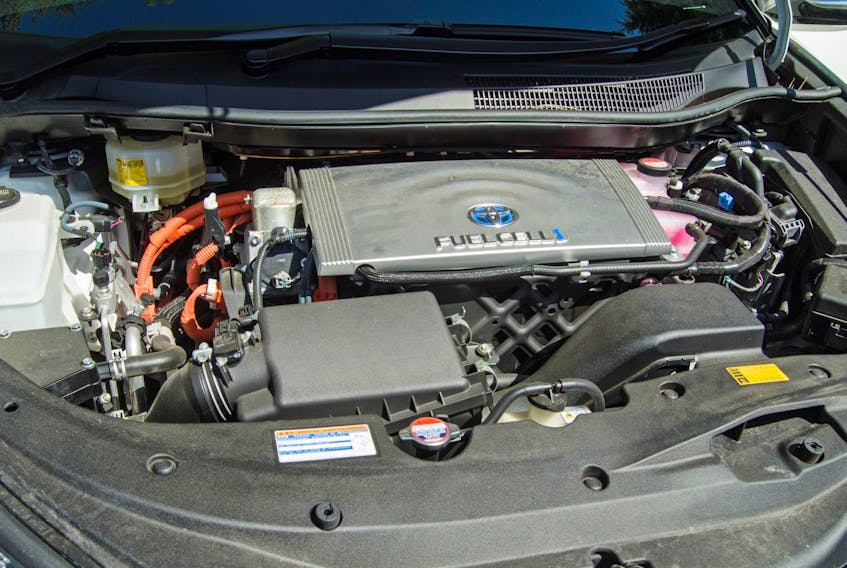Internal combustion engines operating on gasoline dominate the automotive marketplace right now.
But the push to expand the electric vehicle marketplace has been prominent in both the products introduced by auto manufacturers and by government incentives to reduce automotive emissions.
There is another alternative, although it has not been widely promoted, and that is hydrogen.
Hydrogen can be burned in an internal combustion engine similar to propane or natural gas but the real future of hydrogen is in powering fuel cell technology. A typical fuel cell is a series of plates and membranes that combine the hydrogen with oxygen from the air. As the hydrogen passes through the membranes, it creates electricity that can power the vehicle’s electric motors.
This is a very simplified description but the end result is a zero emissions vehicle with water as the only by-product.
Hydrogen has had a bad rap over the years. The dramatic destruction of the Hindenburg airship in 1937, which was filled with hydrogen, remains vivid in many memories thanks to newsreels of the day, but in reality hydrogen is actually safer than gasoline.
When released into the air, hydrogen dissipates rapidly as it is lighter than air. Gasoline fumes on the other hand are extremely explosive and take a while to dissipate.
It’s been said many times that if gasoline were invented today, it would be deemed too unsafe to be used as a fuel! Safe storage and handling are required of all fuels and hydrogen is no exception. In a vehicle, hydrogen is stored under high pressure in carbon fibre, high impact resistant tanks that are many times stronger than steel. Safety valves inside the tank shut off the hydrogen supply if a line is damaged in a collision. From there it is fed into the fuel cell to produce electricity.
A battery is also used to store extra energy so the vehicle has extra energy for acceleration and as storage for electricity generated during regenerative braking. The vehicle computer uses power from the fuel cell and/or battery as driver demands change.
Driving a hydrogen fuel-cell vehicle is very similar to driving any other vehicle and unlike battery-powered vehicles, a hydrogen tank can be refilled is about the same time it takes to fill a gasoline tank.
The biggest problem currently with hydrogen powered vehicles is finding a filling station. The cheapest hydrogen can be extracted from water using high-temperature steam but self-contained electrolysis units powered by electricity can also be used and have almost no environmental impact, but they’re costly to build and install.
Hydrogen is also a good way of storing energy. A battery is also a product used to store energy but producing hydrogen from solar, wind and hydro power sources when consumer electrical demands are low is a viable alternative.
Transporting hydrogen from one source to another is more expensive than gasoline because it must be pressurized to make it a liquid and then transported in high pressure tanks, but this is also feasible. Filling your vehicle at the local station is similar to filling a propane tank!
In Canada, there are currently two hydrogen-powered vehicles for sale: the Toyota Mirai FCV and the Hyundai Nexo FCV. Honda sells the Clarity FCV in the U.S. but could bring it to Canada if demand exists.
Quebec has had the first fleet use of hydrogen powered vehicles and now Toyota and Honda have partnered to build a Montreal filling station for the 50 Toyota Mirai FCV’s in use by the Quebec government. Now British Columbia is the next venue to have these vehicles and filling stations.
The first public hydrogen filling station was recently opened in Vancouver, with more to come. It is expected the Greater Vancouver and Victoria area will have a network of six filling stations by 2020.
As for the future, Hyundai’s FCEV Vision 2030 expects they will build half a million road ready fuel cell vehicles by 2030 as well as 200,000 industrial vehicles.
Hyundai also expects the global market demand to be two million hydrogen powered vehicles by then.
Much of this will occur in overseas countries where emissions are much higher, but the market in Canada will also expand.
The vehicles are ready. Now we need the fuel supply. It’s all a question of which comes first — the chicken or the egg — and with hydrogen powered vehicles, it looks like they will come at the same time.









